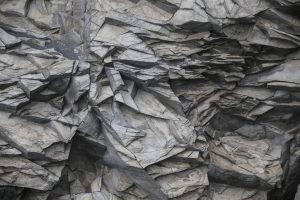Planet Earth is made up of all kinds of rocks. When you know the type of rock you have in your hand, you will know something about the history of the place it came from.
What's a Rock? What's a Mineral? Which Mineral?
A mineral is a rock made up of all the same material. Minerals have names, such as amethyst, quartz, graphite, and so on, and can each be identified. A rock might be a mineral, or it might be a bunch of different minerals put together. Once you know you have a single mineral, you can identify it. First, the color is often helpful. Quartz is yellowish-brown on the outside but often a shiny clear-white inside. Granite is often gray speckled with white and black, while calcite crystals are often a transparent pale yellow, almost as clear as glass. Precious stones often vary only in color –
if a crystal of the mineral called corundum is red, it’s a ruby, but if it’s blue or any other color,
it’s a sapphire!
Hardness is another important clue. Some minerals are much, much harder than others. If a mineral can scratch glass, it’s harder than glass. And if it can scratch another mineral, it’s harder than that mineral. Diamond is the hardest mineral. It can scratch anything, but almost nothing can scratch a diamond—except another diamond! Softer minerals include talc, pumice, and the gypsum inside the wallboard in your walls.
Is the mineral heavy for its size? Then it has what’s called high density. A dense mineral weighs a lot even if it’s small. A less dense mineral, like pumice, is as light as Styrofoam. You can pick up a big block of pumice easily, but don’t try lifting a piece of basalt the size of your head! It probably weighs more than you do.
If color, density and hardness don’t positively identify your mystery mineral, you may be tempted to smash it with a hammer. That can actually help reveal another important mineral property: fracture. The way a mineral breaks is key to identifying it. Slate, for example, breaks into flat sheets when smashed, which is why it’s convenient to use it for blackboards. Calcite’s cleavage breaks it into prisms, and fluorite breaks into eight-pointed shapes.
Armed with your knowledge, you can identify dozens of different kinds of minerals. And, unlike birds, you don’t have to sneak up on them! Though you can if you want to. They won’t mind.
Books for Rock Hounds
You can check out these resources from Central Rappahannock Regional Library to help you identify the minerals you find and see how the rock cycle renews the world around us, from the mountains to the beaches.
Rocks on the Web
Interactive Rock Cycle Animation
A very cool look at the way rocks form.
The Mineral Gallery
Examine minerals by class (elements, oxides, carbonates, etc.). View the chemical formula. Lists properties and histories. Pictorial.
Rock Identification Tables
Once you're comfortable with the rocks you find all around you, check out this table for identifying more unusual rocks. You will need to know whether your rock is igneous (formed by fire), sedimentary (formed by sand or clay, may have fossils), or metamorphic (an igneous or sedimentary rock that has been changed by fire or pressure, or both).
What Are the 3 Types of Rocks?
A nicely illustrated lesson with images of different rock types and a diagram showing how they form. From EarthHow.com
Want to learn more? Check out these books from the library:
Every rock tells a story, whether it was born in fire (igneous), washed into the sea and cemented by tides (sedimentary), or changed by other natural forces (metamorphic). Wherever you are, you can learn about rocks, and understanding the structure of the Earth can help you understand volcanoes, tsunamis, sand dunes, and climate change.



